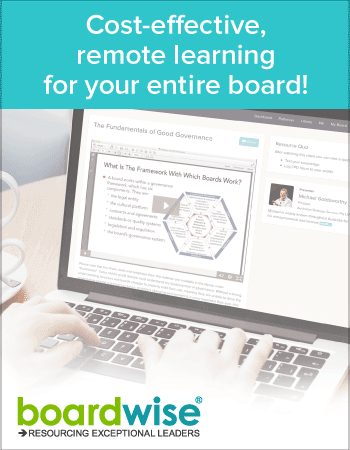10 Tips for Improving Your Board Meetings in 2023
-
governance
Governance 10 Tips for Improving Your Board Meetings in 2023
Board meetings are held so that directors can discuss issues and make decisions that allow their organisation to flourish. Ideally every board meeting will be effective and productive, unfortunately not all meetings are. Board meetings can easily become unproductive and result in waste of time and resources.
In this article we share tips to help you improve your meetings and keep them effective.
1. Use an Agenda Template
The board should agree on a clear templated agenda structure that is used as the basis for each meeting. Using a standardised format means everyone is familiar with how the meetings should run and flow, helping the meeting to stay on track. It also ensures that something is less likely to be missed. It doesn’t mean you can’t make adjustments for each meeting, but all meetings should use the base template when you first start setting the agenda for them.
Ensure that the template is clear and follows a structure that makes sense for your board. A clear agenda will allow members to come to each meeting prepared with questions, concerns, and suggestions, which will lead to more engaged discussions and better decision-making.
2. All relevant meeting information is on the Agenda
The agenda should include everything each person needs to know to attend and participate in the meeting. It should also be distributed to all members well in advance of the meeting. This means attendees have time to review any relevant materials and come to the meeting well prepared.
At a minimum an agenda should include the following information:
- Date and time of the meeting
- Location of the meeting (or relevant digital links)
- List of items to be discussed, in order of priority
- Relevant background materials or documents that members should review prior to the meeting
- The names of any speakers or presenters who will be attending the meeting
- Any decisions that will be made during the meeting
- Time limits for each item
- The names of the members who will be responsible for leading the discussion on each topic.
Ensure that you include space in the Agenda for members to be able to raise new or urgent issues that might need to be addressed.
3. Encourage participation
A board meeting where all directors feel comfortable to participate and contribute is more likely to be productive and result in higher quality decision making. Board meetings should be intentionally designed to encourage participation from all members.
This means working to foster an atmosphere where all members feel comfortable expressing their opinions and ideas, without fear of being judged or dismissed. The chair plays a vital role in facilitating this by promoting open communication and ensuring everyone is able to contribute and each member actively listens to other members’ contributions.
Other ways to encourage participation include:
- Assign meeting roles and responsibilities to specific members.
- Assign each discussion item to a discussion lead
- Have a timekeeper (who is not the minute taker) to keep the meeting on track
- Using technology and digital tools to help encourage participation if some members cannot be there in person.
4. Use technology
Technology can play an important role in improving board meetings. Board portal software including Our Cat Herder can be used to speed up meeting preparation and board pack distribution, while also allowing meetings to run more smoothly by embedding best practices, such as Agenda Templating, into meeting systems and processes.
One of the key benefits of board meeting software is the ability to facilitate communication and collaboration among members. Additionally board software tools can be used to share documents, assign tasks, and track progress, which can help to improve efficiency and keep everything on track.
5. Schedule all meetings in advance
Regular board meetings are essential for staying on top of important issues and making timely decisions. Boards should schedule all meetings in advance so they happen on a regular basis, such as monthly or bi-monthly, to ensure that important issues are addressed in a timely manner.
Meetings should not be held so frequently that they become burdensome or overly time-consuming. It is also important to ensure that there is enough time between meetings to allow for members to prepare for the next meeting and to follow-up on any action items from the previous meeting.
Regular meetings can help to foster a culture of accountability and responsibility among directors, as they will know that there will be a consistent time for discussing and making decisions on important issues.
6. Evaluate your meetings
After each meeting, the board should take time to evaluate the effectiveness of the meeting and identify areas for improvement. This can be done by conducting a simple survey to gather feedback and suggestions from directors.
By taking the time to evaluate the meeting, the board can identify areas for improvement and make changes to ensure that future meetings are more productive, efficient, and effective.
There are many areas of your meetings you could evaluate, such as the agenda, the participation of members, and the decision-making process. However even just using a simple post meeting survey that covers the three areas below can easily reveal some areas for meeting improvement:
- Please rate the effectiveness of the agenda and use of time per agenda item (scale Poor to Excellent)
- Please rate performance of the chair in this meeting. (scale Poor to Excellent)
- Did you feel that all board member were well prepared for this meeting? (yes, no - why not?)
7. Build a Diverse board
To get the most from your board meetings, you need to have the right people around the table. This means having a diverse group of individuals with different perspectives, experiences, and skills.
Having a diverse board is crucial for effective decision-making. Diversity brings different perspectives, experiences, and skills to the table, which can lead to more creative solutions and better decision-making.
When building a diverse board, it is important to consider diversity in terms of not only ethnicity or gender, but also in terms of age, education, background, experience, and skillset. This can help to ensure that the board has a wide range of perspectives, which can be beneficial when making important decisions.
Having a diverse board is not only important from a social and moral perspective, but also from a business perspective. A diverse board can help to ensure that the board is making the best possible decisions, and that it is well-positioned to help ensure the organisation flourishes.
8. Provide governance training
Providing governance training is an essential step in ensuring that all board members are equipped with the knowledge and skills they need to be effective in their roles. There are many governance training providers out there, one such example which is cost-effective and easy to access is BoardWise by Better Boards.
Governance training helps to ensure that board members are aware of their roles and responsibilities, and that they are equipped with the knowledge and skills they need to effectively govern the organisation. This will lead to better decision-making, improved communication and collaboration among members and ultimately, better performance of the organisation.
9. Keep accurate and well organised minutes:
Keeping accurate and well-organised minutes is an essential step in ensuring that all board members are informed and on the same page. Minutes are a formal record of the decisions and discussions that take place during a meeting. They provide a summary of the key points discussed and the decisions made, and they serve as a reference for future meetings.
Having a secretary or a designated minute taker to take minutes is important for ensuring that the minutes are accurate and complete. This person must be present at the meeting and should be responsible for taking detailed notes of the discussions and decisions that take place. The minutes should include:
- The date, time and location of the meeting
- The names of the members present and absent
- A summary of the key points discussed
- A record of any decisions made and any action items assigned
- Any votes taken and the results of the votes
- Any other important information relevant to the meeting
It is important that the minutes are distributed to all members in a timely manner. This will allow members to review the minutes and to prepare for the next meeting. The minutes should also be kept in a central location, such as a shared drive or a cloud-based platform, where they can be easily accessed by all members.
Additionally, keeping accurate and well-organised minutes can also help to ensure that the organisation is in compliance with any legal or regulatory requirements. Minutes are often used as evidence of compliance with laws, regulations, and organisational policies, and they can also be used in legal proceedings as evidence of the decisions and actions taken by the board.
10. Follow-up on action items:
One of the most important aspects of a board meeting is to ensure that decisions and actions are captured and then implemented. To ensure that this happens, the board should establish a system for capturing and following-up on action items from the meeting (Our Cat Herder can help streamline this).
When capturing actions you want to ensure that actions are:
- assigned to a specific person to be responsible for each task
- setting deadlines for completion
- and regularly checking in on progress.
By following up on action items, the board can ensure that decisions made during the meeting are translated into real-world results, and that the organisation is making progress towards its goals.
By taking these suggested steps, boards can improve the effectiveness of their meetings and make better use of the time and resources of their members. With clear agendas, open participation, governance training and the use of technology, board meetings can become more productive, efficient, and engaging.
Resources
Board Meeting Mastery: How Should a Chairperson Run the Meeting?
Three Ingredients for Meetings: Agendas, Minutes and Follow up Actions
Your Guide to More Effective Board Meetings
When should you schedule your board meetings?
How Well Is Your Board Managing its Scarcest Resource?
The Importance of Getting Your Agendas and Minutes Right
Frequently Asked Questions
How does a board meeting work?
A board meeting is a formal meeting of an organisation's board of directors to discuss and make decisions on various matters. The board meeting process typically looks like the below:
- Scheduling and notification: Board meetings are scheduled in advance with date, time, and location shared with board members.
- Preparation: An agenda is prepared, and relevant materials are distributed to board members before the meeting.
- Conducting the meeting: The chairperson calls the meeting to order, minutes from the previous meeting are reviewed, reports and presentations are given, and discussions and decision-making occur on each agenda item.
- Action items: Decisions made result in specific action items assigned to board members or staff.
- Follow-up: After the meeting, minutes are prepared, and progress on action items is tracked for future meetings.
What is the importance of board meetings?
Board meetings are crucial for the effective management and governance of an organisation. They play a vital role in:
- Strategic decision-making: Board meetings steer the organisation's course and establish priorities.
- Oversight and accountability: They ensure compliance with legal and ethical standards.
- Problem-solving and risk management: Meetings facilitate addressing challenges and seizing opportunities.
- Information sharing and communication: These gatherings promote transparency and well-informed decision-making.
- Networking and relationship building: Board meetings help nurture collaboration within the leadership team.
- Resource allocation: They enable the efficient use of an organisation's resources.
- Legal compliance: Holding regular meetings upholds fiduciary duties and legal responsibilities.
What should be discussed at a board meeting?
At a board meeting, essential topics to discuss include:
- Approval of minutes: Review and approve the minutes from the previous meeting.
- Financial reports: Discuss the organisation's financial performance and budgetary matters.
- Strategic planning: Review, update, and assess the progress of strategic initiatives and goals.
- Operational updates: Address significant operational issues, challenges, or developments.
- Committee reports: Receive updates and recommendations from various committees.
- Risk management: Identify and evaluate potential risks, and devise mitigation strategies.
- Legal and compliance: Discuss any legal, regulatory, or compliance-related matters.
- New business: Raise additional concerns or propose new ideas and initiatives.
Who runs a board meeting?
A board meeting is typically run by the chairperson or president of the board. Their key responsibilities include:
- Setting the agenda: Collaborating with other board members and the executive director to establish discussion topics.
- Facilitating discussions: Encouraging open communication, ensuring all members have the opportunity to contribute.
- Time management: Keeping the meeting on track and adhering to the allotted time for each agenda item.
- Decision-making: Guiding the board to make informed decisions and overseeing the voting process, if necessary.
- Summarising outcomes: Ensuring that decisions and action items are clearly documented and understood by all members.
How often do board members meet?
The frequency of board meetings varies depending on the organisation's needs, size, and legal requirements. Common meeting schedules include:
- Monthly: Suitable for organisations requiring frequent decision-making and oversight.
- Quarterly: Allows for regular review of progress and strategic planning without overburdening board members.
- Bi-annually: Works for smaller organisations with less frequent decision-making needs.
- Annually: Minimum requirement for many organisations, typically coincides with the annual general meeting (AGM).
How long should a board meeting last?
The duration of a board meeting depends on the agenda and the organisation's needs. Generally, a board meeting should be:
- Efficient: Limit the meeting to a reasonable time frame, typically 2-4 hours, to maintain focus and productivity.
- Focused: Ensure that discussions stay on topic and adhere to the allotted time for each agenda item.
- Flexible: Allow for some flexibility in case certain topics require extended discussion or new issues arise.
- Respectful: Be mindful of board members' time commitments and avoid unnecessary lengthy meetings.
Who prepares the agenda for a board meeting?
The agenda for a board meeting is typically prepared by:
- Chairperson or President: They work closely with other board members and the executive director to establish discussion topics.
- Executive Director or CEO: They may collaborate with the chairperson to include updates on operations, finances, and strategic initiatives.
- Board Secretary: They may assist in the preparation and distribution of the agenda, as well as gather relevant supporting materials.
- Committee Chairs: They can contribute by suggesting items related to their committees' work for inclusion in the agenda.
Do all directors have to attend board meetings?
While it is highly recommended that all directors attend board meetings, there are some considerations:
- Quorum: Ensure that the minimum number of directors required by the organisation's bylaws or legal requirements is present for decision-making.
- Participation: Encourage all directors to attend meetings to ensure diverse perspectives and informed decision-making.
- Alternatives: Offer remote attendance options, such as video or teleconferencing, for directors unable to attend in person.
- Attendance policies: Establish clear expectations and guidelines for board member attendance in the organisation's bylaws or governance policies.
Are board meetings confidential?
Board meetings often involve discussions on sensitive matters, so confidentiality is typically expected:
- Confidentiality agreements: Directors may be required to sign agreements to maintain confidentiality of discussions and materials.
- Executive sessions: Closed-door sessions may be held for discussing sensitive matters, such as personnel issues or legal concerns.
- Information security: Ensure secure handling and storage of meeting materials, minutes, and other confidential documents.
- Communication: Directors should exercise discretion when discussing board matters outside the meeting context.



